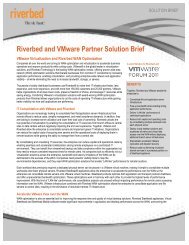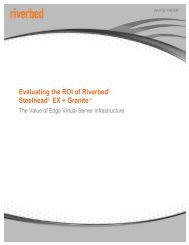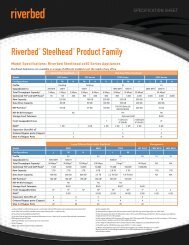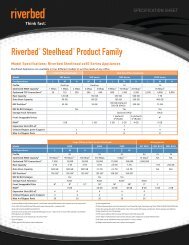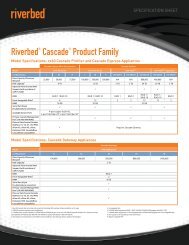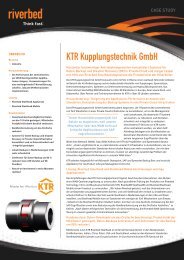Riverbed Optimization System (RiOS) 6.1
Riverbed Optimization System (RiOS) 6.1
Riverbed Optimization System (RiOS) 6.1
Create successful ePaper yourself
Turn your PDF publications into a flip-book with our unique Google optimized e-Paper software.
<strong>RiOS</strong> Technical Overview<br />
server TCP implementations, it is often challenging to configure correctly. In many Windows versions, correctly configuring<br />
window scaling requires esoteric knowledge of relevant settings and a willingness to edit the Windows registry – requirements that<br />
place window scaling out of reach for many organizations. Even with the appropriate knowledge and skill set, making these<br />
changes on every server in a large enterprise may require large amounts of administrative overhead and may not be a very<br />
scalable approach.<br />
<strong>RiOS</strong> enables automatic window scaling across the WAN without requiring the user to make any changes to clients, servers, or<br />
the routing infrastructure. Beyond simple window scaling, however, is the software’s ability to virtually expand TCP windows and<br />
enable capacity that is hundreds of times greater than basic TCP payloads. As a TCP proxy, <strong>RiOS</strong> effectively repacks TCP<br />
payloads with a mixture of data and references to data. As noted in the data streamlining section, recognized data that would<br />
have been transported is instead replaced by a reference, which can represent a very large amount of data. In this manner, <strong>RiOS</strong><br />
virtually expands the TCP frame, often by a factor of several hundred or more. This Virtual Window Expansion (VWE)<br />
dramatically reduces the number of roundtrips that need to be taken to deliver a given amount of data.<br />
Figure-10: Virtual Window Expansion massively increases TCP payload by intelligently repacking the TCP Payload.<br />
High Speed TCP and Max Speed TCP<br />
A less-well-known problem is that it is often hard for a TCP connection to take advantage of available bandwidth on highbandwidth,<br />
high-latency links, or in situations where packet loss is high. The <strong>RiOS</strong> implementations of High Speed TCP (HS-TCP)<br />
and Max Speed TCP (MX-TCP) can accelerate TCP-based applications so that a single connection runs at hundreds of Mbps (up<br />
to OC-12, 622 Mb/s) even when round-trip latencies are high. The potential benefits include:<br />
• Higher throughput over long distance high bandwidth links<br />
• Faster replication, backup and mirroring over very long distances<br />
• Better utilization of high bandwidth links<br />
HS-TCP achieves full utilization of investments in network bandwidth without losing or compromising any of the essential<br />
characteristics and benefits of TCP. These benefits include safe congestion control, even when HS-TCP connections share WAN<br />
links with “normal” TCP connections. Familiar TCP performance characteristics have been preserved. For example, there is no<br />
need to pre-determine available WAN bandwidth – HS-TCP self-adjusts transmission throughput appropriately.<br />
In contrast, MX-TCP allows administrators to take advantage of 100 percent of a prescribed amount of bandwidth connectivity<br />
between any two locations. Whereas HS-TCP will back down in speed as a result of significant packet loss or congestion, MX-<br />
TCP is designed to use a set amount of bandwidth regardless of congestion or packet loss. Administrators can easily set the<br />
bandwidth limit for MX-TCP, enabling this functionality without requiring use of the total bandwidth available on a given<br />
connection.<br />
Connection Pooling<br />
Some applications are designed to open many TCP connections in order to accomplish required data transfers. Many of these<br />
connections are short-lived, yet each requires significant overhead to initiate communications.<br />
Such short-lived connections can result in significant reductions in application speeds. For example, loading a single ordinary Web<br />
© 2010 <strong>Riverbed</strong> Technology. All rights reserved. 11




